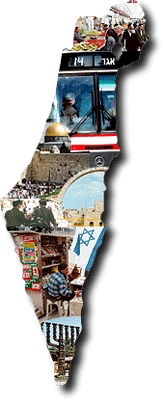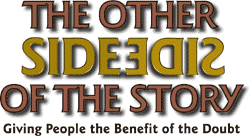Light Lines - Naso
Parshat Naso
14 Sivan 5760 / 17 June 2000 (Outside Israel)
7 Sivan 5760 / 10 June 2000 (Inside Israel)
Ohr Somayach Home Page
THE SAME OLD SONG
An imaginary conversation: "Wow! What a concert! I've never heard the London Symphony play like that. Their Brahms' First was absolutely superb!"
"I dunno. I heard the Boston Pops last week. They played the same tunes..."
Or how about the following:
"Ian McKellen's Iago must rate as one of the definitive Shakespearean interpretations of the century..."
"Yeah, but didn't Shakespeare write any other tragedies? I mean, they do Othello, followed by Hamlet, followed by Macbeth followed by King Lear and then back to Othello again. Occasionally they throw in Antony and Cleopatra for a change, but then it's back to the same old stuff over and over and over...."
After Moses finished building the Tabernacle, he sanctified it and all its vessels and utensils. Then, the leaders of the twelve tribes brought offerings to inaugurate the Holy Altar. They brought their offerings one at a time, one a day for the first twelve consecutive days of the Tabernacle's Divine service. The Torah faithfully records in detail the offerings that each of the princes brought. It just so happens that they were all identical. Absolutely identical: "...one silver bowl, its weight a hundred and thirty (shekalim); and one silver basin of seventy shekalim in the sacred shekel, both of them filled with fine flour mixed with oil for a meal-offering; one gold ladle of ten (shekalim) filled with incense; one young bull, one ram, one sheep in its first year for an elevation-offering; one male goat for a sin-offering; and for a peace-offering: Two cattle, five rams, five male goats, and five sheep in their first year."
Not a short list. The Torah repeats this exact list over and over again. Twelve times.
Why couldn't the Torah have just written that all the princes brought identical offerings? The Torah never wastes a word, a letter or even a dot. If the Torah wrote a seeming redundancy twelve times, there must be a good reason.
The answer is that the offerings weren't identical. Each one was infused with the individual enthusiasm of the prince who brought it. Each one was permeated with the unique personality of its owner, his own personal devotion, his own spiritual striving.
Like two performers who can take an identical piece of music and imbue it with an individuality that makes both performances unique; like an actor who can wring from lines which have been said for hundreds of years a new and original interpretation, so too each of the twelve princes of the tribes of Israel brought the spiritual uniqueness of himself and his tribe as an offering to his Creator.
|
Ohr Somayach Home Page |
 Selections from classical Torah sources which express the special relationship between the People of Israel and Eretz Yisrael THE MISSING INGREDIENT "Let my tongue cleave to my palate if I do not remember you, if I do not bring up the memory of Jerusalem at the peak of my joy." This is the source for the long-standing tradition of breaking a glass at weddings. The shattered glass reminds us that our joy is not complete as long as the Holy Temple has not yet been rebuilt. Another dimension is added by the great eighteenth century scholar, Rabbi Yonason Eybshutz of Prague, in his classic "Ya'arot Devash". Even if a Jew should have achieved all of his heart's desires, he writes, it is incumbent upon him to remember that he is still missing the most important ingredient for success as long as he is not in the Land of Israel with the Temple rebuilt, only there can he achieve ultimate fulfillment and happiness. |
|
Ohr Somayach Home Page |
It's never too early to learn how to judge others favorably, and we're never too old to learn a valuable lesson -- even from a young source.
Brat's Love
My story is about how I misjudged a friend. Last year a new girl came to my school. I immediately thought she would be kind of a brat. I decided that she would not be my friend and that I would have nothing to do with her. I realized that I had totally misjudged this girl when I first met her. It turns out that as the days went by, we became really good friends and then we became best friends.
|
Ohr Somayach Home Page |
Tattoo and Jewish Burial
Claudette Maxim wrote:
I came across an article that stated that a Jewish person may not be buried in consecrated grounds if he or she has a decorative tattoo. Is this true?
Dear Claudette,
No, it's not true. This seems to be a widespread misconception, and many people have asked us this question.
The Torah explicitly forbids a Jew from getting a tattoo: The verse says "Don't put hypodermic writing in your flesh, I am the Lord."
Thus we see that getting a "decorative" tattoo is considered a sin for a Jew, but it doesn't disqualify him from being buried in a Jewish cemetery.
Rabbi Chanoch Teller relates the story of a young man from a non-religious upbringing who returned to traditional observance of Judaism. Remaining from his former lifestyle was a tattoo which he carefully kept hidden under his shirtsleeves.
Before Yom Kippur, this young man went to the mikveh, the ritual bath, as is the custom. Try as he might, he couldn't hide his tattoo from the others at the mikveh. His embarrassment was noticeable. Then, an elderly Jew approached him: "Don't be embarrassed," said the old man as he held up his arm to show the numbers tattooed there by Nazis. "I also have a tattoo."
Light Insight | Love of the Land | The Other Side of the Story | Response Line Ohr Somayach Home Page |
Produced by the Office of Communications
Editor: Raphael Scott Leban
Production: Eliezer Shapiro
HTML Production: Michael Treblow
© 2000 Ohr Somayach International - All rights reserved. This publication may be distributed to another person intact without prior permission. We also encourage you to include this material in other publications, such as synagogue newsletters. However, we ask that you contact us beforehand for permission, and then send us a sample issue.
Ohr Somayach Institutions is an international network of Yeshivot and outreach centers, with branches in North America, Europe, South Africa and South America. The Central Campus in Jerusalem provides a full range of educational services for over 685 full-time students.









